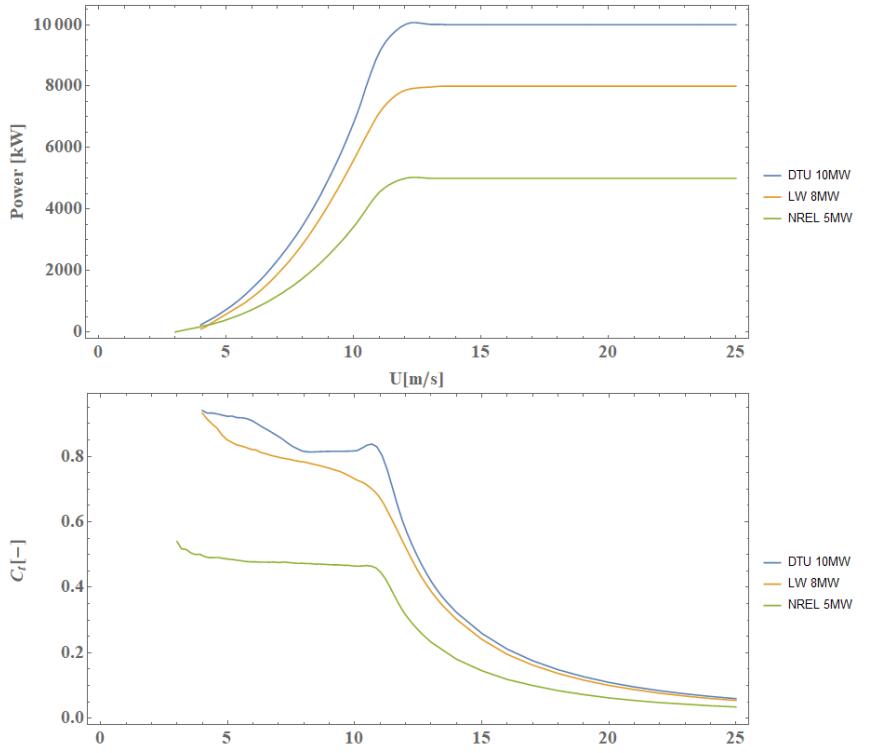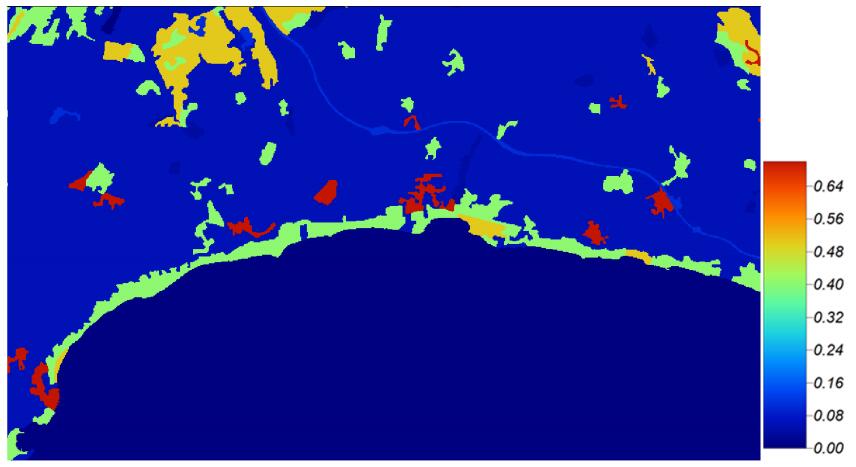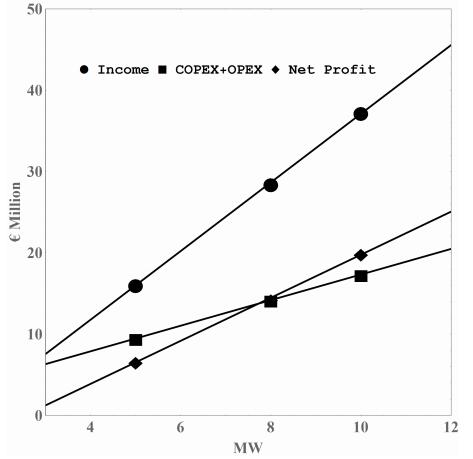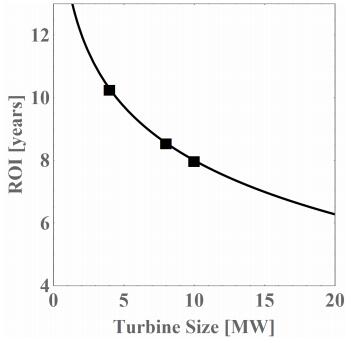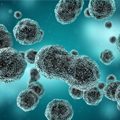1. Introduction
The first European offshore wind farm, Horns Rev I with a capacity of 160 MW, was built in 2002. Since then/to date several others have been added, mainly in northern European waters, bringing the total offshore capacity in Europe to around 1.3 GW [1] by 2016. The near-future expectations were even higher; WindEurope reports that between 2017–2020 the capacity will rise to 11.6 GW, reaching 24% of the future installed capacity worldwide [2].
The reasons to move to offshore sites are primarily three; (ⅰ) better wind resources [3,4] thus higher capacity factors and 75% more energy production [5] (ⅱ) less complex terrain and (ⅲ) higher public acceptance. Although, it seems like a natural choice to move offshore in wind energy invest- ments, there are also major challenges for offshore wind energy. Firstly, the foundation cost is one of the main considerations, because in order to create a feasible investment, places with a sea depth¡60m are needed [4,6,7]. In recent years, the development of floating wind turbine designs is opening the potential to overcome such depth constraints, thereby enlarging the area suitable for offshore wind farms [7,8,9]. A second major challenge is the unknown wind resources at offshore locations. Making conventional measurements at offshore locations is much more expensive compared to onshore sites. Nevertheless, the latest developments in satellite wind measurement techniques enable us to at least make a pre-investigation of the resource and find the best possible mast location before embarking on any measurement campaign [10,11,12]. Satellite derived Same datasets can also be used to validate large scale and numerical wind atlas studies [13,14].
Offshore sites are not only rich with wind but also with underground fossil fuel resources. These energy sources were investigated much earlier than wind energy and have been exploited since the 19th century [15]. The basic energy resource extraction method involves an in-situ platform, where the energy source is reached via a drilling process under the seabed. A platform is erected with an average of 40 years of structural life-time capacity. These platforms become non-feasible if the energy source is no longer sufficiently profitable to extract at the current drilling depth or when the platform reaches its end-of-life. In the first case, a possible use of such a platform is to alter the energy source from gas/oil to wind energy by simply erecting a wind turbine on the platform and produce in-situ electric energy and transfer to the land. The idea is being discussed since 1993, mostly for California offshore locations and Mexican Gulf installations of the USA where the first oil rig was decommissioned in 1996 [16]. At the time, several environmental and economic/financial studies were undertaken in order to understand if the idea was feasible, but the conclusions were negative (insert references somewhere here) due to several reasons. The main reason was the production capacity. Platforms have rather small surface areas and the separation between turbines should be at least 2 rotor diameters not to get effected from each other. As a result, one could only allocate a single turbine on each platform which was not enough to make profit from the investment at the begging of the millennium, when turbine capacities were around 2 MW. Nevertheless, in the USA, the Energy Policy Act of 2005 authorized the alternative use of existing oil and natural gas platforms for marine energy renewable projects [17]. At that time the biggest designed capacity of turbine was 4.5 MW and averaged standard turbine was 1.5MW. This step shows a general interest in using platforms for other purposes. There is no such similar act in Europe but in 2009 there was an attempt to convert several offshore rigs into wind energy platforms [18] around Scotland which shows the revival of the interest on the subject with the new generation wind turbines that can reach up to 10 MW capacity.
In this study, three new generation offshore wind turbines are used to create a scenario of converting a gas platform into an offshore wind turbine base. The results are compared in terms of Levelized Cost of Energy (LCOE) and total profit rate, based on the local feed-in-tariff. The core aim of the study is to identify the minimum turbine capacity that renders conversion of existing offshore platforms feasible and how low the Return of Investment (ROI) and LCOE can be.
2. Theory and method
In Turkey, Turkish Petroleum Cooperation* (TPAO) which is a state investment with public shareholders is focused on gas and oil investments and has license for offshore exploration and production. The company has erected 5 platforms in the last 60 years.
*In Turkish-Türkiye Petrolleri Anonim Ortaklıǧı-http://www.tpao.gov.tr
TPAO first built the North Marmara† in $1997$ to extract gas resources from a relatively near-shore location around Silivri. The platform was successfully operational until $2013$ but is currently under consideration for decommissioning due to the high cost of rigging, despite having a minimum of 20 years more lifespan in general conditions. The platform is situated at $45$ m sea depth and almost $2.5$–$3$ km from the shore of Silivri village near the city of Istanbul and its height is approximately $20$ m (Figure 1).
†"Kuzey Marmara" in Turkish and official documentation
2.1. Reference wind turbines
In recent years, several institutes and companies have published their conceptual design for wind turbines with capacity equal to or bigger than 5 MW. The aim of these theoretical studies is to overcome common problems of the wind turbines due to the growing sizes. The design criteria of these, so-called "reference", turbines were determined for offshore locations, due to the three positive points mentioned in the introduction of this article thus reducing the number of challenges to deal with at the same time. The most well-known concept wind turbines are designed by 1) the National Renewable Energy Laboratories (NREL) of USA [19], 2) the FP7 funded EU project Logistic Efficiencies And Naval architecture for Wind Installations with Novel Developments LEANWIND (LW) (based on Vestas V164) [20,21] and 3) the Technical University of Denmark (DTU) of Denmark [22,23]; the design capacities are 5 MW, 8 MW and 10 MW respectively. Power and thrust curves of these turbines are publicly available and have been used in previous studies (Figure 2).
Table 1. Reference turbine characteristics [23].
| NREL | LW | DTU |
| Rated Power [MW] | 5 | 8 | 10 |
| Rotor Diameter [m] | 126 | 164 | 178.3 |
| Hub Height [m] | 90 | 110 | 119 |
| Cut-in [m/s] | 3 | 4 | 4 |
| Cut-off [m/s] | 25 | 25 | 25 |
| Total Mass [tones] | 662 | 968 | 1198 |
2.2. Wind resources
In-situ meteorological mast measurements are needed in any wind farm project development process. A minimum yearly dataset gives a good average of the wind energy density at the location and can be used to predict annual energy production (AEP) with industry standard applications.
At offshore locations, such as North Marmara, a mast installation costs much more than on onshore locations, therefore other available techniques are employed for initial assessment studies. If the initial studies give expectant results one can erect a mast on the location and collect data for at least 1-year. There are several options that can be used for pre-assessment wind data but the most common ones are based on remote sensing measurement instruments. In the last two decades, satellite wind measurement technologies are developed with Synaptic Aperture Radar (SAR) [24] and Scatterometer (SCAT) [25] techniques. The data is mostly open source but difficult to process and of low quality due to high uncertainty (±2 m/s). Several studies imrpoved our knowledge on offshore wind profiles [26,27,28,29]. An even newer technology, Light Detection and Ranging (LiDAR) has also showed promising signs for offshore measurements [30]. Newly designed floating lidar platforms make it possible to measure anywhere within a reasonable depth range [31]. It is also possible to use long range lidars and scan the near-shore areas from the coast up to 4 km distance [32].
It should also be stated at this point that current international wind farm development standards only require in-situ measurement with conventional mast. Therefore, the TPAO was invited to this study to give access to the platform and its structural information but the company did not show any interest in erecting a mast on the platform or participating in the study. When in-situ measurements were precluding it was also not feasible to try any other remote sensing technique which would need TPAO's consensus and partnership. Nevertheless, one other trustworthy option for wind resources, the Global Wind Atlas (GWA) version 2 was finalized in November 2017 is used in the study. In GWA the whole globe is modeled with $\frac{1}{12}^{\circ}$ resolution [14]. The study uses long term re-analysis datasets as input and state-of-the-art down-scaling methodologies to create a global atlas. Therefore, GWA version 2 has been chosen as the yield assessment model input for the wind characteristics in the region.
The North Marmara gas platform is located at $41^{\circ}3$'$4.34$" N and $28^{\circ}11$'$6.98$" E. The closest three GWA calculation nodes are shown in Figure 3-LEFT with red circles. The three nodes were used to make an atlas interpolation to the platform location following the methodology in [33] (Figure 3). The interpolation result of the atlas showed leading wind direction to be between $30^{\circ}$ to $60^{\circ}$, which is very common in the region.
The atlas data has been downscaled by means of the industry standard software WAsP ‡ is used. There are several other methods and commercial application for the purpose, using linear or non-linear flow model solvers. The choice has been made based on avalibility, being most exercised by the author and specially because it includes Charnock's theorem [34] which makes seperate calculations for wind over the sea.
‡WAsP Version 11.4 http://www.WAsP.dk
The application uses Wind Atlas Methodology [35] and requires elevation and roughness information of the area. The digital elevation model dataset, SRTM version 4.1§ [36], was used for the elevation information above sea level and for the coastline (Figure 4). The roughness of the surroundings is characterized by open area, short trees on the land not very close to the shoreline, and patches of forest with trees of approximately 5–12 m height at some coastline locations. There is also a village at the main wind direction of $30^{\circ}$. The aerodynamic roughness of the area was split into 8 different classes and the CORINE Land Cover 2012 dataset¶ polygons were used to identify the borders of each class; moreover the polygons were altered based on aerial imagery findings (Figure 5). The wind atlas was applied to the platform location and the three reference turbine AEPs were calculated (Table 2). The growth of AEP is not linear to the turbine size as expected. The capacity factor (CF) of each turbine reaches up to almost 40%.
§Available from the CGIAR-CSI SRTM 90m Database (http://srtm.csi.cgiar.org).
¶European Environment Agency (EEA), the Copernicus programme https://land.copernicus.eu/pan-european/corine-land-cover/clc-2012/view.
Table 2. AEP for each turbine for the same platform location based on GWA2 information.
| Turbine | A[m/s] | k[-] | U[m/s] | P[W/km$^2$] | AEP[MWh] | CF[%] |
| NREL (5MW) | 8.0 | 2.13 | 7.07 | 388 | 15010 | 34.3 |
| LW (8MW) | 8.4 | 2.14 | 7.47 | 456 | 26595 | 38.0 |
| DTU (10MW) | 8.6 | 2.15 | 7.66 | 491 | 34761 | 39.7 |
2.3. Cost model
After getting the AEP values, it is possible to predict the income of the power plant and the trans- mission costs. The other cost units are applied from the study of [37]. The study breaks down the cost into operational expenditure (OPEX) and capital expenditure (CAPEX) parts with linear equations as a function of the relative variable of each case (e.g. sea depth, distance to shore, installed capacity). In some cases, adjustment to local market was necessary and was applied in this study. The following assumptions and adjustments were made:
● It was assumed that the platform does not need extra structural support to bear any of the reference turbines. Thus, the cost of the turbine and its installation were kept as onshore costs in CAPEX but with additional offshore O & M in OPEX. This assumption is further discussed in the Results section.
● No substation was planned because the platform is 2 km away from the shore and the cabling can easily reach an onshore substation with minimal transportation loss.
● Standard Turkish transmission costs were applied to the cost model because the suggested European cost is significantly higher than the national prices. The cost per kWh is set yearly by the state and depends on the installed capacity and the energy production which are around €3600/MW and €0.02/kWh, respectively, for the year 2018.
● Production losses due to the maintenance and electrical array are common in any wind farm and 10% of total loss was added to the calculation at "income" item but no other losses were applied to the final cost.
3. Results
The cost of an offshore wind turbine or wind farm installation are not unknown and it is well studied in Europe. Nevertheless, same conditions are not available in Turkey. There is not any offshore wind turbine in Turkey as the date of this study is published. Therefore, a latest study [37] has been chosen to be the main data source on cost in every stage of the development; only minor change has been made to the feed-in-tariff. Ebenhoch et. al uses several data sources for different items of the cost and O & M and fit these statistical data into linear function, which makes it easy to apply and derive cost based on distance to the shore, size of the turbine and depth of the sea.
When the cost model is applied to the three different cases, the 20 years OPEX costs are seen to be around 30–35% of the CAPEX cost for each turbine but the revenue increases linearly with wind turbine capacity 6). 8MW seems to be the minimum turbine capacity to make revenue from such a project as the net profit only goes positive after such installed capacity. When the ROI of each scenario is calculated, a minimum of 8 years is needed for the return of investment even with the assumption of no extra structural upgrade for the platform. Furthermore, the LCOE is very similar for the 8 MW and 10 MW scenarios (Table 3). As a last step, the AEP for each turbine had been calculated as well as the return of investment (ROI) and the capacity factors (Table 3).
Table 3. CAPEX and OPEX figures of the three reference turbines with return of investment (ROI) and Levelized Cost of Energy (LCOE) per kWh.
| Turbine | NREL | LW | DTU |
| Size[MW] | 5 | 8 | 10 |
| CAPEX |
| Project Development | €1 076 438 | €1 076 438 | €1 076 438 |
| Turbine | €4 734 366 | €7 746 636 | €9 826 336 |
| Cables and Installation | €1 170 000 | €1 872 000 | €2 340 000 |
| TOTAL | €6 980 804 | €10 695 074 | €13 242 774 |
| OPEX (20 years) |
| Project Management | €1 101 072 | €1 101 072 | €1 101 072 |
| O & M | €266 250 | €347 520 | €369 000 |
| Transmission | €1 117 089 | €2 049 363 | €2 625 429 |
| TOTAL | €2 484 411 | €3 497 955 | €4 095 501 |
| PRODUCTION (20 years) |
| AEP [GWh] | 300.2 | 531.9 | 695.22 |
| Income | €16 075 710 | €28 483 245 | €37 229 031 |
| Capacity Factor | 34.3% | 37.9% | 39.7% |
| Net Profit | €6 610 495 | €14 290 216 | €19 890 756 |
| ROI | 10.3 years | 8.6 years | 8 years |
| LCOE [cent/kWh] | 2.20 | 2.69 | 2.86 |
4. Conclusion
In this study, a feasibility analysis of offshore gas platform conversion was undertaken, combining an up-to-date calculation method of energy yield assessment and a cost model adapted for local conditions. The WAsP software with digital elevation and roughness model were used, with wind characteristics of the location extracted from GWA version 2. The cost model for offshore and onshore installations developed in a previous study was adapted for the unique case of the study and altered for Turkish market where necessary. There are important points to be considered before making any conclusions. First, in this study, two important and unknown costs are present; (ⅰ) the necessary upgrade cost of the platform to make it suitable to bear/withstand the operational forces of a wind turbine of 8 MW or more (ⅱ) the financial cost due to the commercial loan. It was not possible to take these two important costs into account for the calculations because no information regarding the structural requirements of the platform was shared by the owner and it is not certain what can be the interest rate for such an investment loan in Turkey. On the other hand, the current calculation gives the figure for the best-case scenario and an indication of what should be investigated for further improvement. The combination of models gives a clear outlook of feasibility for suggested scenario and the results indicated that 8 MW or above wind turbine can create a feasible and low-cost energy investment. With a 20 MW turbine the ROI can be further lowered to 6 years (Figure 7).
Acknowledgments
Wind Atlas Data is obtained from the Global Wind Atlas 2.0, a free, web-based application developed, owned and operated by the Technical University of Denmark (DTU) in partnership with the World Bank Group, utilizing data provided by Vortex, with funding provided by the Energy Sector Management Assistance Program (ESMAP). For future information: https://globalwindatlas.info.
Conflict of interest
The author declares that there are no conflicts of interest in the paper.









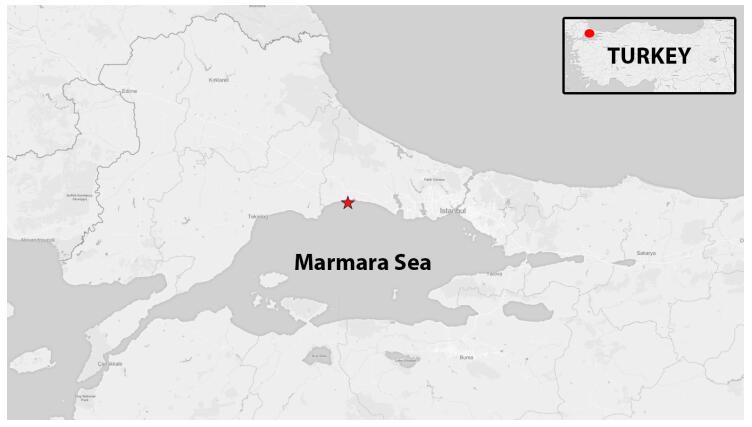
 DownLoad:
DownLoad: 